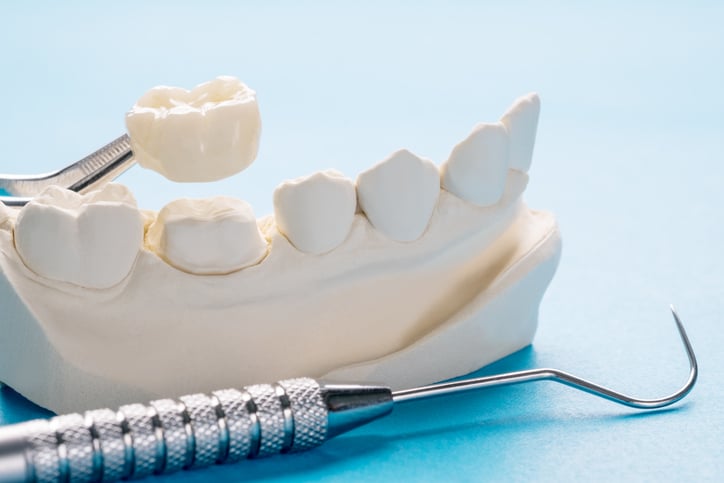When Should I Replace My Dental Crown?

What is a dental crown?
A dental crown (or cap) is a custom-made tooth-shaped restoration that covers the entire visible part of the tooth(s). This artificial layer wraps the remaining natural tooth structure and gives it a fresh outer surface. Crowns are generally made from strong materials such as porcelain, ceramic, resin, or metal alloys.
Dental crowns are vacuous on the inside to fit over the prepared tooth, and they appear almost like a small helmet or armor of a larger size. Afterward, the crown is cemented onto or bonded to the tooth, leaving it enclosed. This saves the tooth underneath it and gives it its original shape, size, power, and beauty.
Purpose of dental crowns
Dental crowns have multiple roles in dentistry’s remedial and aesthetic aspects.
- Protecting a weakened tooth: When the inside of a tooth is severely decayed, already cracked, or weakening due to large fillings, a crown can provide needed strength and protection against further damage or potential fracture.
- Restoring a broken or worn-down tooth: If a tooth needs to be rebuilt to its damaged shape or size due to grinding, erosion, or blunt trauma, a crown will be used.
- Supporting a tooth with a large filling: If a tooth already has a large filling, usually taking a large portion of the tooth tissue, the crown would be additional support and protection to prevent the leftover part of the tooth from being broken or cracked.
- Anchoring a dental bridge: Caps usually crown the teeth next to the gap on both sides and create supportive and anchor points for a bridging prosthesis that replaces missing teeth.
- Improving the appearance of teeth: Dental crowns have the potential to change the shape, color, and appearance of uneven, discolored, or imperfect teeth, leading to a better-looking smile.
- Completing a root canal treatment: The next step typically involves fitting a crown on the tooth that has been the subject of the root canal so that the area is sealed and protected. This helps prevent further damage, such as infection.
- Restoring dental implants: Crowns are also in place to preserve the protruding part of dental implants, restoring a natural look and function simultaneously.
Dental crowns are beneficial restorations that can address an enormous spectrum of functional or aesthetic problems. Wearing a crown strengthens, protects, and reshapes teeth.
Signs You Need to Replace Your Dental Crown

Dental crowns are no exception; a restoration is only temporary. However, with time, their quality might be degraded, or they may even start wobbling, which makes replacement an inevitable choice. Here are some signs that indicate it’s time to replace your dental crown: Here are some signs that indicate it’s time to replace your dental crown:
Cracks or chips in the crown
- If the crown has cracks or chips, it will be clear evidence that the dental crown needs replacement. They also cause the extreme of the gum tissues to not make close friends with the teeth, which is called gum recession and gum disease. Besides damaging the structure of the teeth, stenosis can further damage the teeth, especially if left untreated.
- Tiny breaks or stains seem meaningless in the beginning. Later, however, this will mean something other than peaceful. Instead, the phenomenon will cause the crown to break or entirely fall apart. On the extra side, these openings in the cap crown surface allow bacteria and food particles to mold, causing tooth decay and infection underneath such cover.
- It’s wise to fix broken or chipped crowns right away, for the dental structure lies underneath, and the sensitivity, Pain, and risk of further damage or decay can increase as time passes.
- The dental cement can harbor and enable all the microbes that chew away on the tooth underneath the crown.
- Using a crown on a tooth does not guarantee the protection of tooth decay underneath it, especially if the period of wearing the crown is inclined to increase or there are spaces and gaps through which bacteria can accumulate.
Tooth decay underneath the crown
- A dental crown helps to protect the tooth, but tooth decay can still form under a crown unless the crown is of high quality and its inner core is tight.
- If you feel Pain, tenderness, or discomfort, a problem may be caused by a decay or infection hidden under the crown. This could be because, for example, your oral hygiene was not good enough, a poor fit of the crown, or you had a condition that wasn’t treated before your crown was put on.
- Crowns do not always prevent the tooth decay beneath them from going unnoticed. The decay can progress and result in further problems when it is not treated early enough. At your scheduled dental visits, the dentist can examine the surrounding area around the crown, and they will suggest replacement if decay is found.
Loose or ill-fitting crown
- A crown that shifts or wavers should be taken seriously and dealt with immediately. A crown that wiggles is uncomfortable and can prevent proper chewing or speaking. It can also increase the chance of falling off.
- Moreover, crowns that are not sufficiently secured will create gaps or spaces where food and bacteria can accumulate, which can damage teeth and gums or cause a mouth infection. This can happen if the tooth underneath the crown has changed position or if the crown is worn out or damaged with time.
- If it is revealed that your crown is not fitting correctly or feels different, a dental visit is highly recommended immediately. They could put the crown back or decide that a replacement is required due to an issue with the fitting, which could lead to some other troubles.
Receding gums
- Recession of gum is a known dental problem that can arise from a significant number of causes, including gum disease, brushing the teeth too aggressively, or, indeed, simply getting older. In addition, as gums recede from the roots of the teeth, the cavity around the tooth deepens. Thus, the surface of the crown is seen.
- This gap could become a sort of ‘safe shelter’ for bacteria, promoting decay, gum inflammation, and potential bone loss around the affected area. In addition, when the gums recede, the tooth root above is exposed to external elements, thus increasing the root’s sensitivity or color and undermining your smile.
- The tendency of receding gums around a dental crown should never go unnoticed because it must be treated thoroughly to prevent further complications. Sometimes, your dentist could urge you to replace your temporary crown as it may not fit properly and, most importantly, avoid additional problems. Overall, they can offer methods of treating gum recession (e.g., gum disease treatment using scaling and root planing or changing the way you brush).
Conclusion
Dental crowns benefit your health and appearance, so they are a worthwhile investment, but they don’t last forever. Awareness of the signs of necessary replacement and knowledge of the factors that affect crown longevity will allow you to take proactive measures to ensure that your dental crowns remain in good condition as long as possible. At Dental Designers, we offer a single-visit dental crown procedure, which is an easy way to get the crown.

